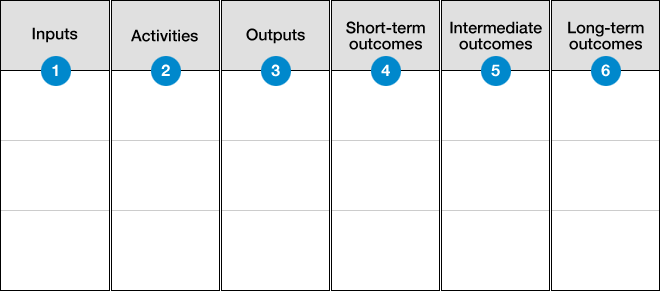The Logic Model Template
There are different templates and formats for logic models which depict varying levels of complexity and detail. In public health, two often used logic model frameworks are the PRECEDE-PROCEED Model and Intervention Mapping. For this training program, a simple six column template is used to demonstrate the overall logic, or thinking, behind the program design and the relationships between the components of a typical logic model and to help develop skills in how to create an accurate, comprehensive logic model.
For the simple six column logic model, program developers must identify six components of their program. These include:
- Inputs – resources that go into the program as the foundation for program activities; these are things like money, staff, and communication that are needed before the program starts,
- Activities – the planned events or actions of the program; these are the processes or services staff create and deliver to the intended population,
- Outputs – the direct products of activities that can be measured in countable terms such as the number of sessions held or number of people served,
- Short-term outcomes – changes that result from the program’s activities and outputs such as changes in knowledge, skills, behaviors, attitudes, status, and level of functioning; to identify short-term outcomes we can ask, “What can we expect to change if program participants are exposed to the intended amount of program activities and outputs?”
- Intermediate outcomes – changes that result from the program’s short-term outcomes such as changes in knowledge, skills, behaviors, attitudes, status, and level of functioning; to identify intermediate outcomes we can ask, “What can we expect to change if program participants achieve short-term outcomes?”
- Long-term outcomes – changes that result from the program’s short-term and intermediate outcomes such as changes in knowledge, skills, behaviors, attitudes, status, and level of functioning; to identify long-term outcomes we can ask, “What can we expect to change if program participants achieve short-term and intermediate outcomes?”

